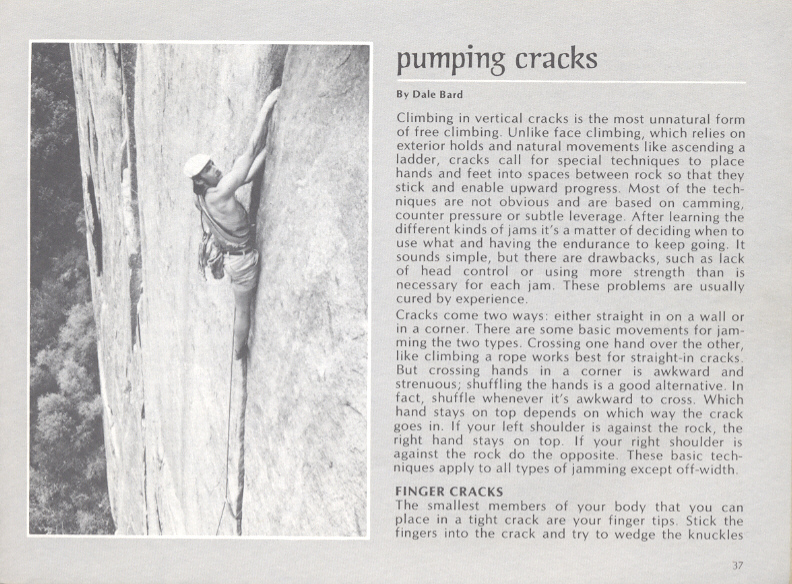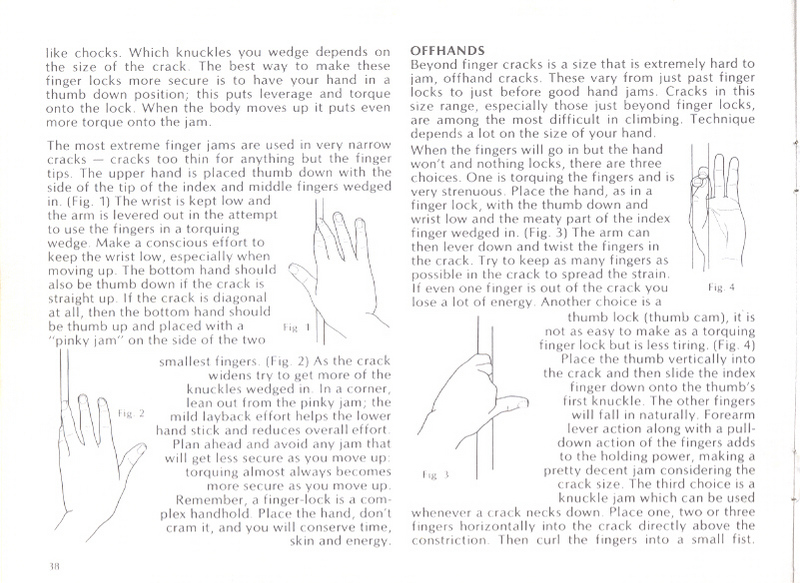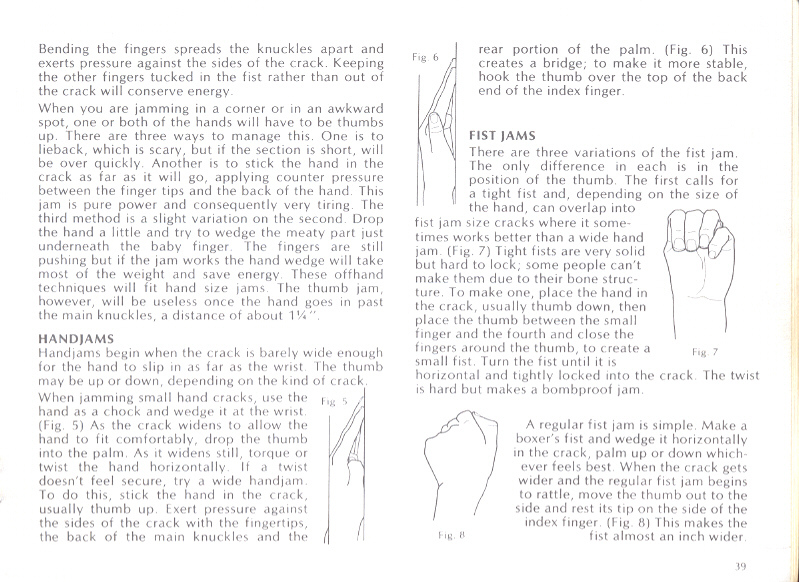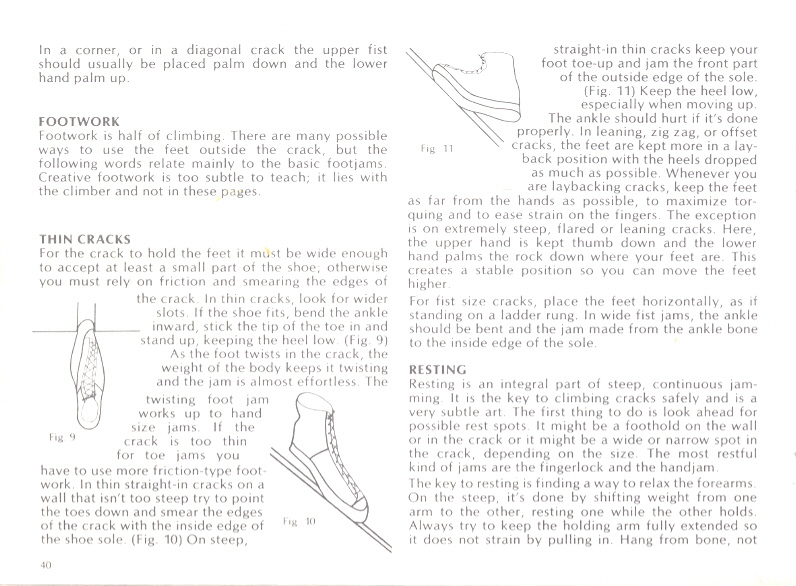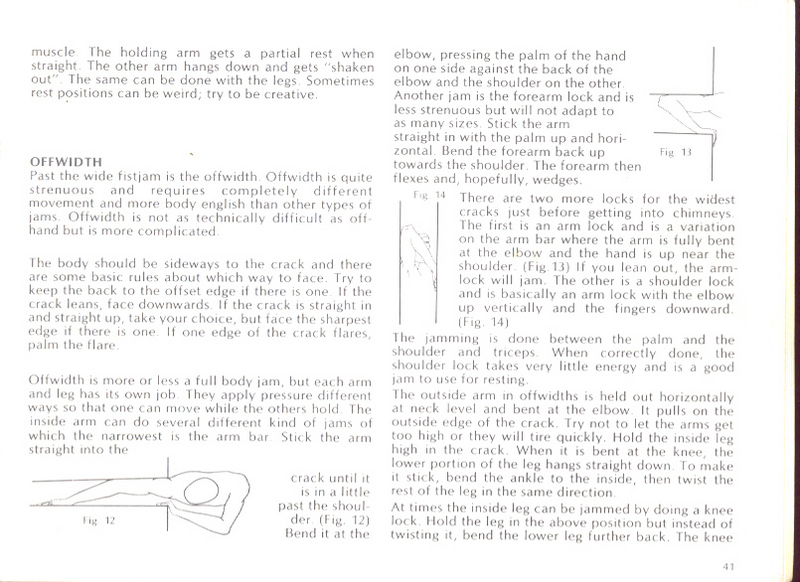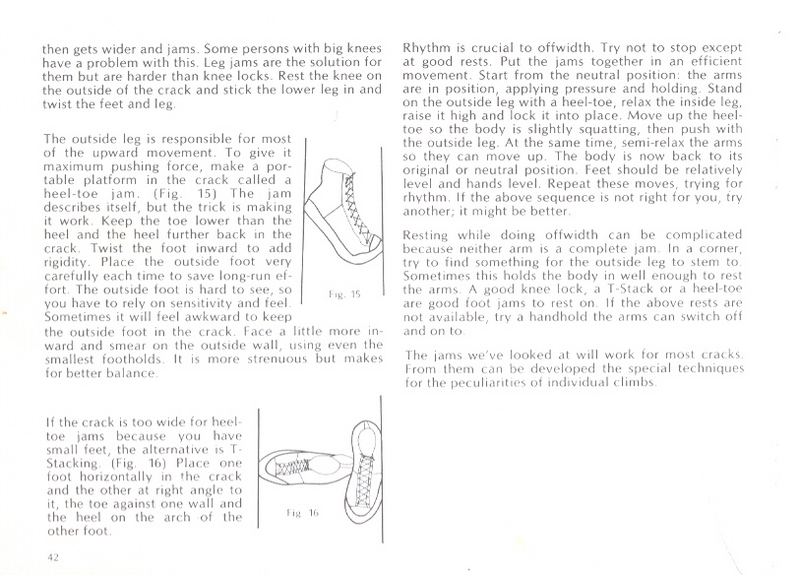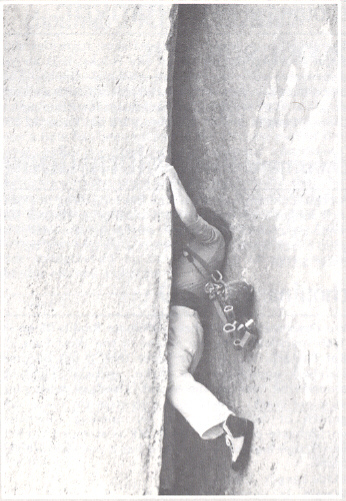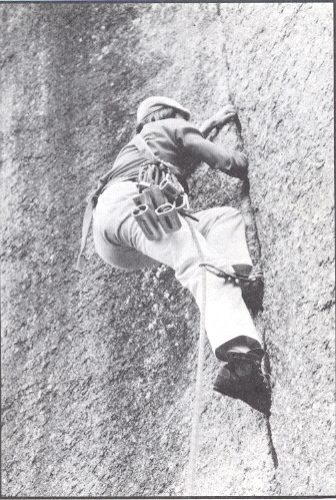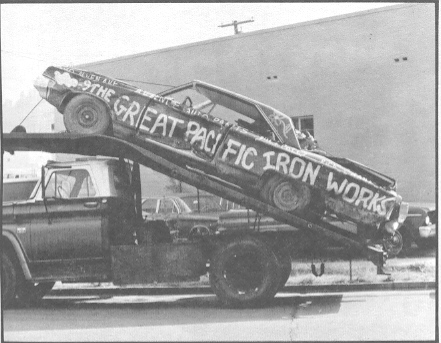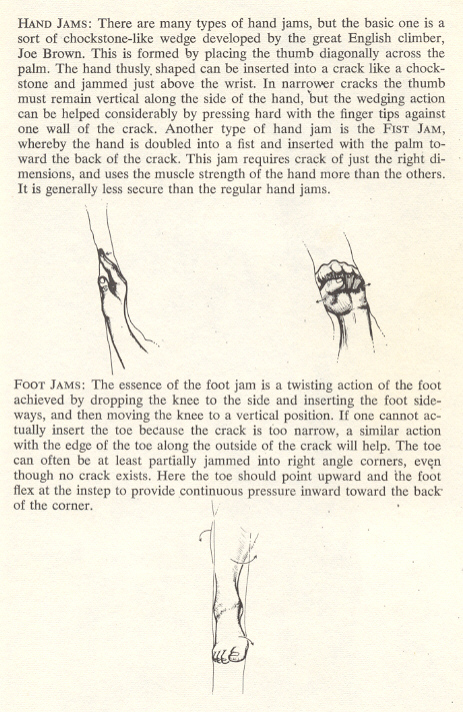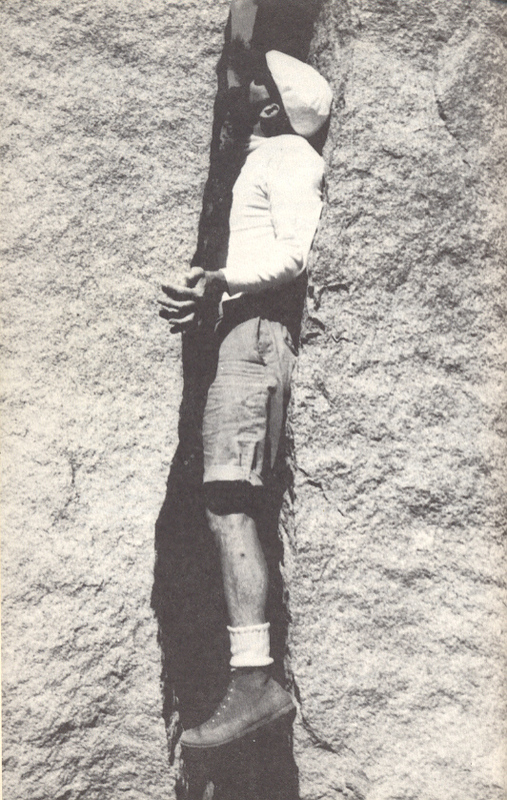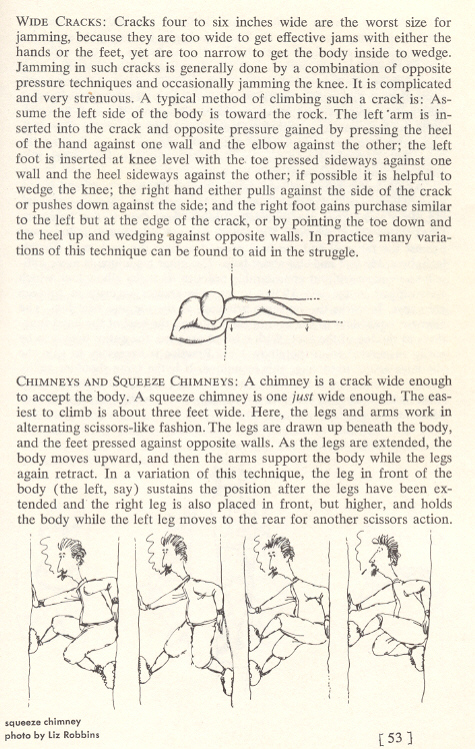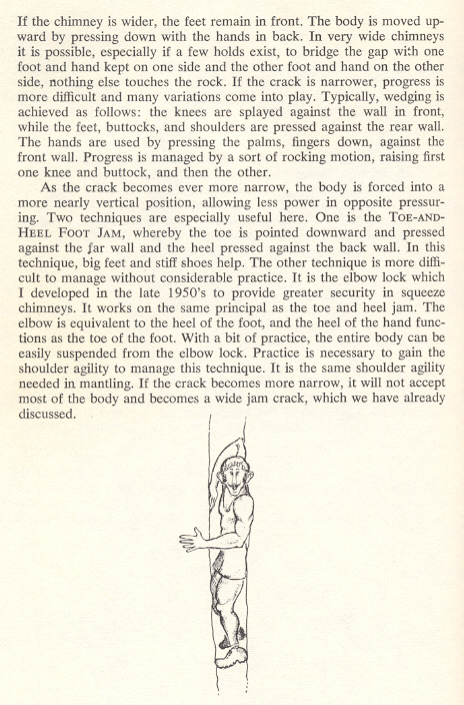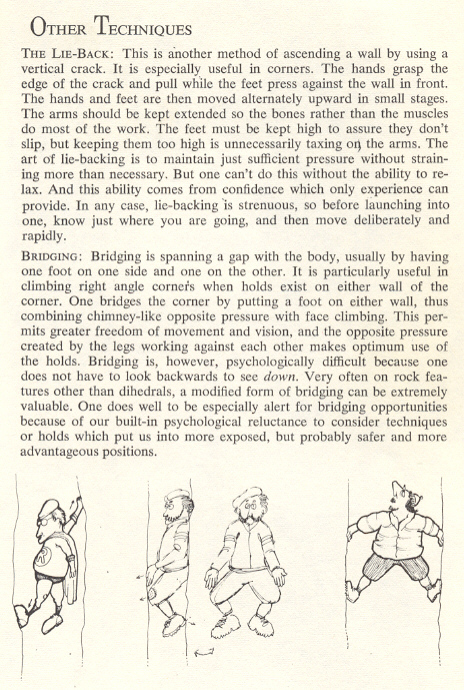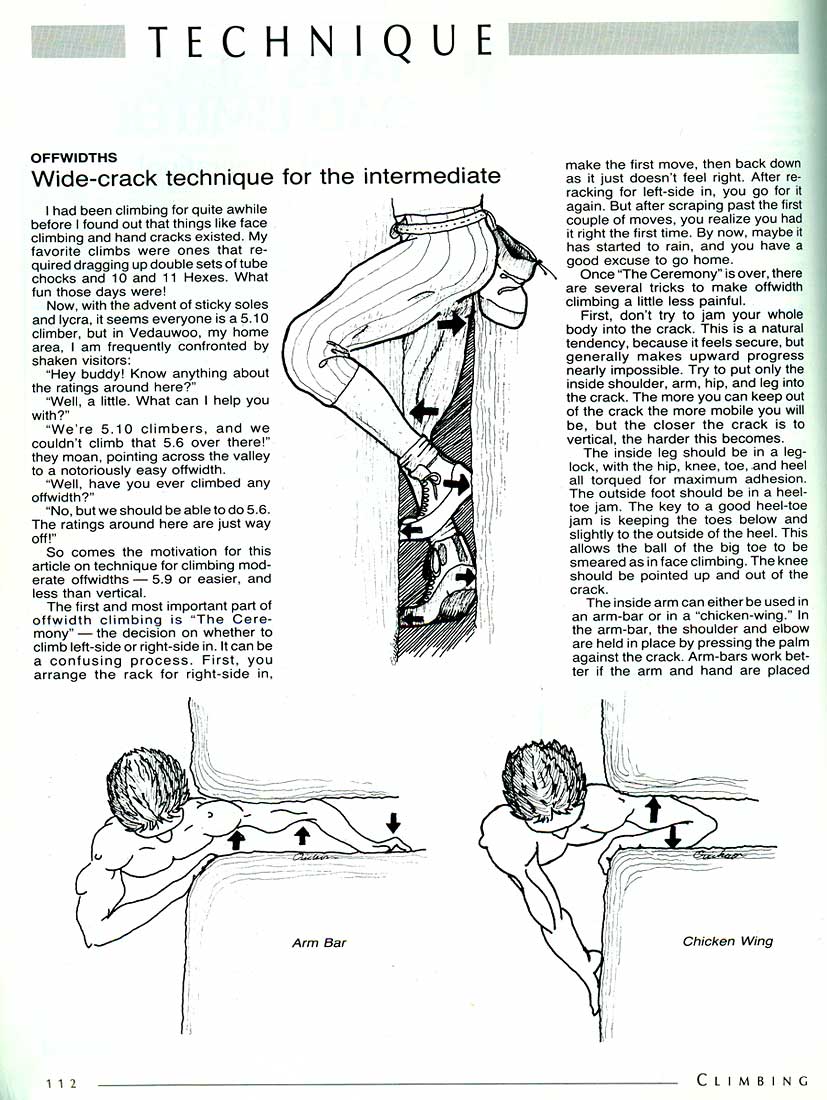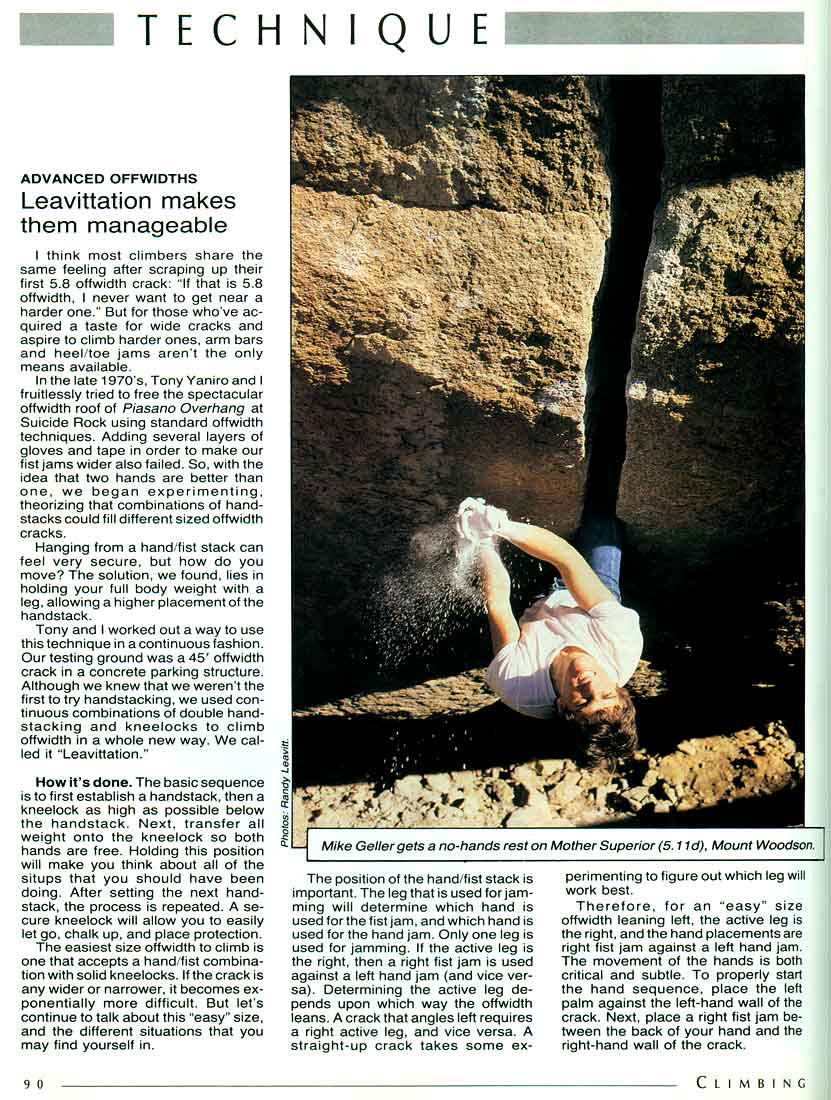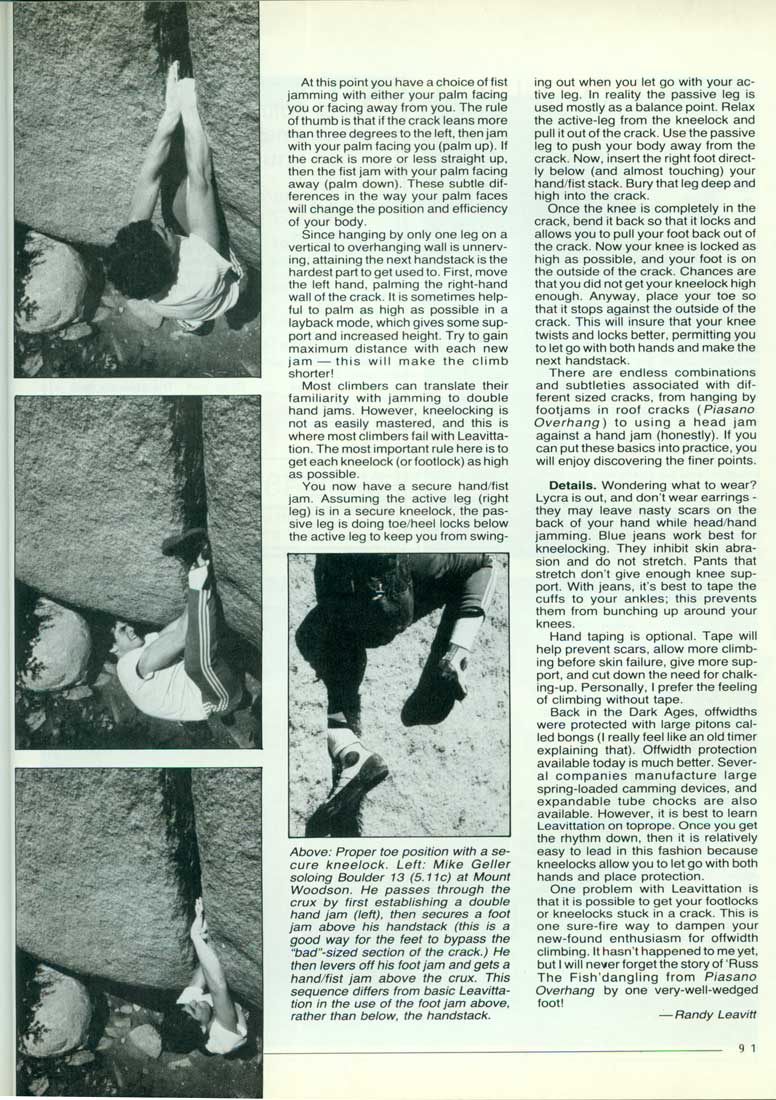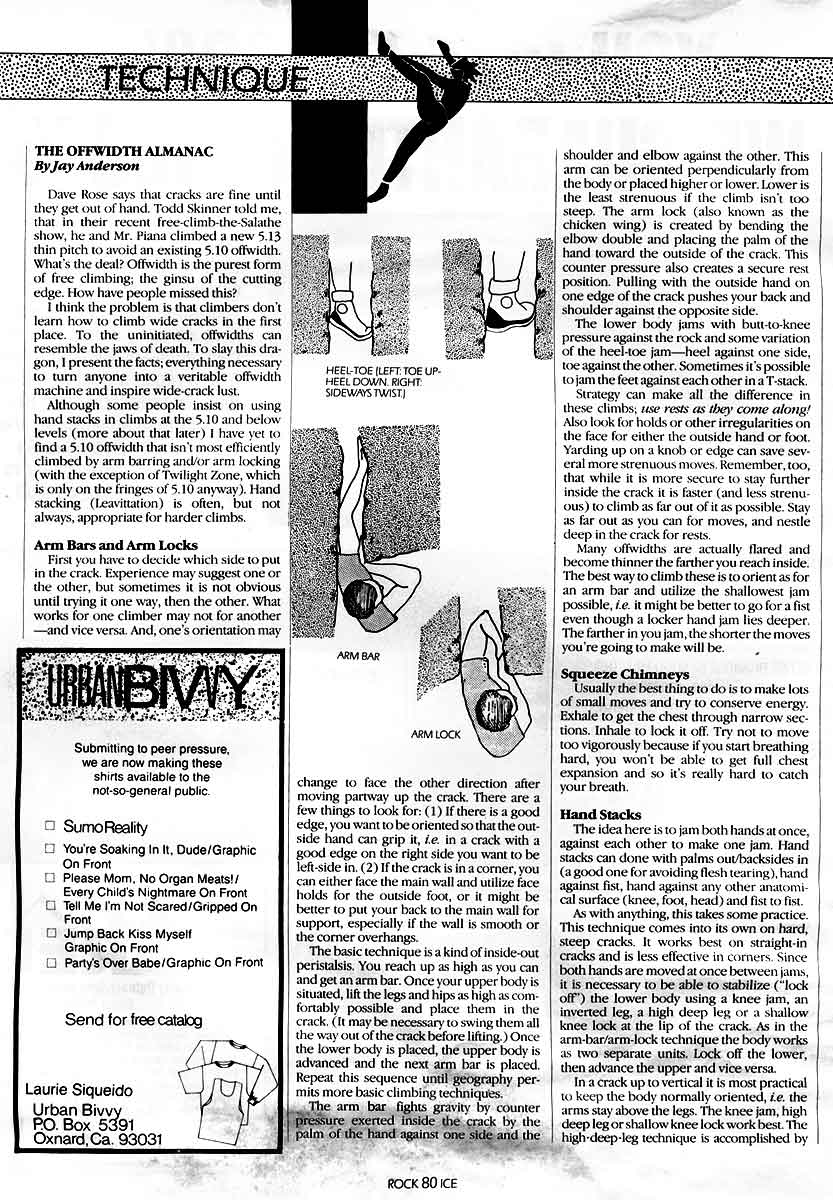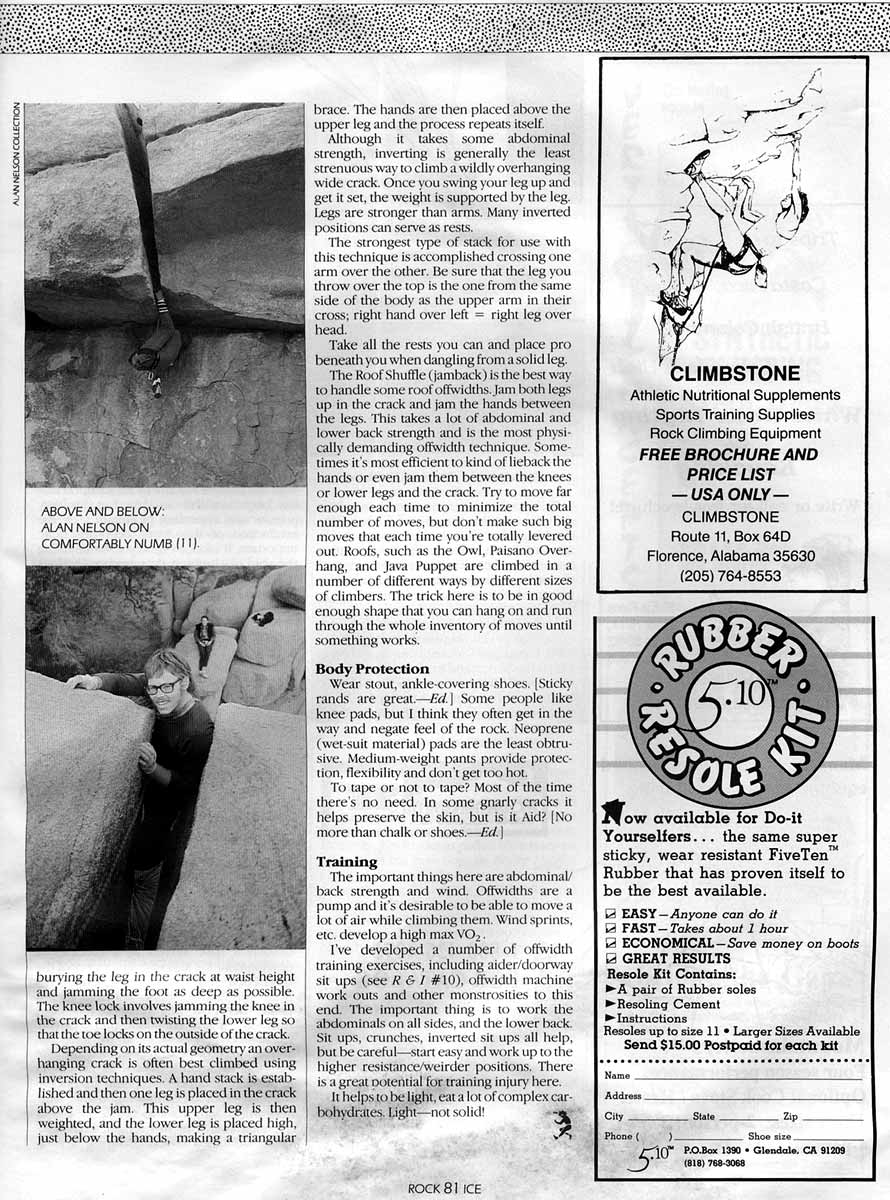
How To Do The Wide
A collection of tips and tricks that just might let you experience the wide
as it was meant to be... controlled, blood loss free, and efficient.
Leavittation: The Offwidth Renaissance,
by Randy Leavitt
Pumping Cracks, by Dale Bard
Rock Craft, jamming technique, by Royal
Robbins
Intermediate Wide Crack Technique,
by Layne Kopischka
Advanced Offwidths, by Randy Leavitt
Offwidth Almanac, by Jay Anderson
Leavittation: The Off-Width
Renaissance
Here is the article from Mountain Magazine with the text in readable format
below, thanks to Will.
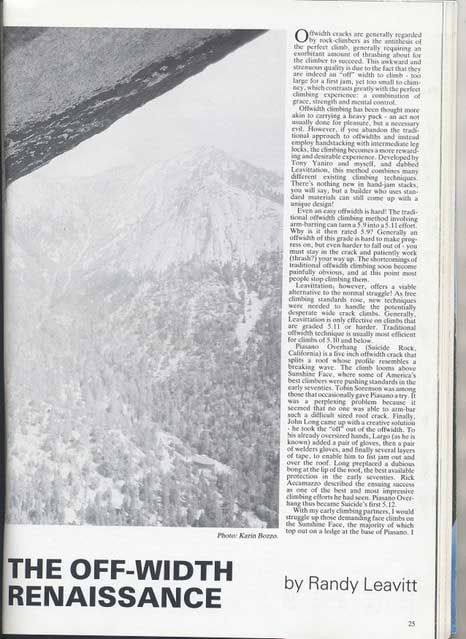
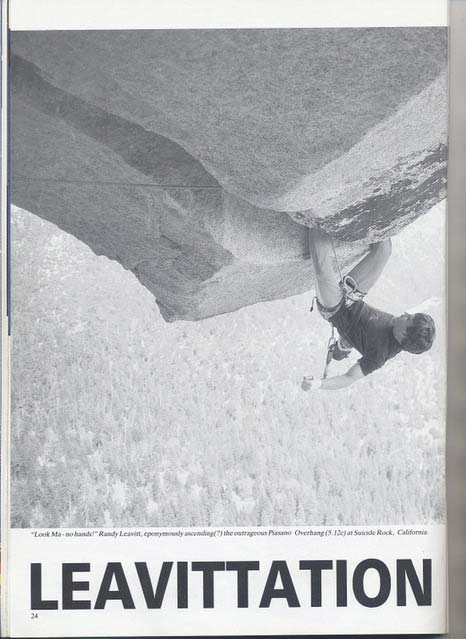
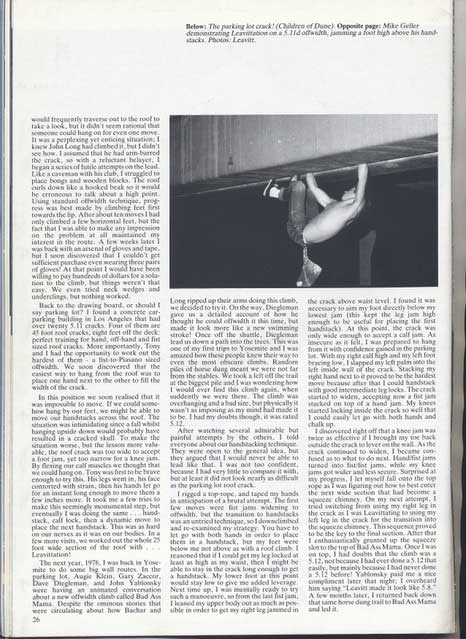
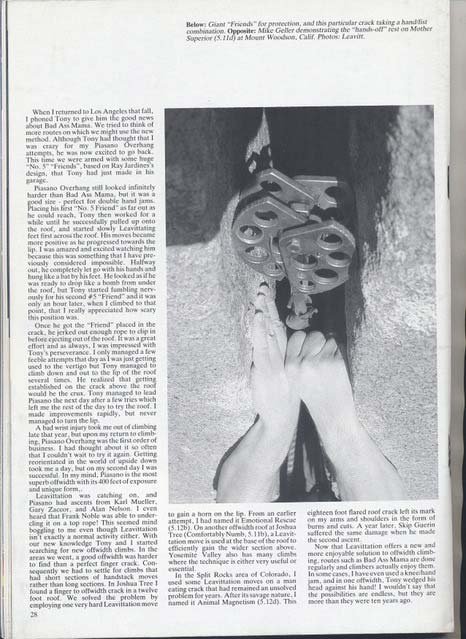
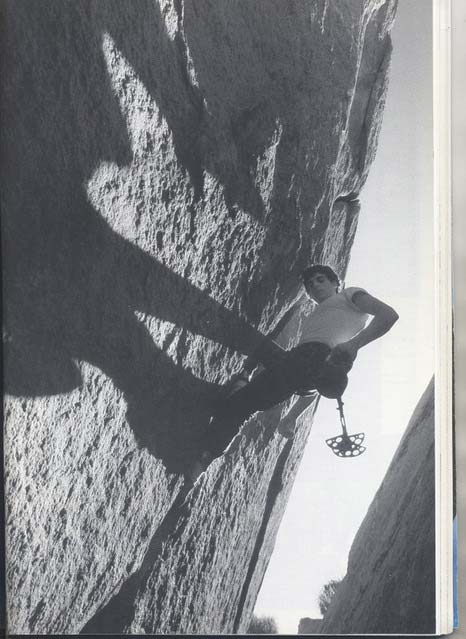
From Mountain Magazine #106
Leavittation: The Off-Width Renaissance, By Randy Leavitt
Offwidth cracks are generally regarded by rock climbers as the antithesis
of the perfect climb, generally requiring an exorbitant amount of thrashing
about for the climber to succeed. This awkward and strenuous quality is due
to the fact that they are indeed an "off" width to climb - too large
for a fist jam, yet too small to chimney, which contrasts greatly with the
perfect climbing experience: a combination of grace, strength and mental control.
Offwidth climbing has been thought more akin to carrying a heavy pack - an
act not usually done for pleasure, but a necessary evil. However, if you abandon
the traditional approach to offwidths and instead employ handstacking with
intermediate leg locks, the climbing becomes a more rewarding and desirable
experience. Developed by Tony Yaniro and myself, and dubbed Leavittation,
this method combines many different existing climbing techniques. There's
nothing new in hand-jam stacks, you will say, but a builder who uses standard
materials can still come up with a unique design!
Even an easy offwidth is hard! The traditional offwidth climbing method involving
arm-barring can turn a 5.9 effort into a 5.11 effort. Why is it then rated
5.9? Generally an offwidth of this grade is hard to make progress on, but
even harder to fall out of - you must stay in the crack and patiently work
(thrash?) your way up. The shortcomings of traditional offwidth climbing soon
become painfully obvious, and at this point most people stop climbing them.
Leavittation, however, offers a viable alternative to the normal struggle!
As free climbing standards rose, new techniques were needed to handle the
potentially desperate wide crack climbs. Generally, Leavittation is only effective
on climbs that are graded 5.11 or harder. Traditional offwidth technique is
usually more efficient for climbs of 5.10 and below.
Piasano Overhang (Suicide Rock, California) is a five inch offwidth crack
that splits a roof whose profile resembles a breaking wave. The climb looms
above Sunshine Face, where some of America's best climbers were pushing standards
in the early seventies. Tobin Sorenson was among those that occasionally gave
Piasano a try. It was a perplexing problem because it seemed that no one was
able to arm-bar such a difficult sized roof crack. Finally, John Long came
up with a creative solution - he took the "off" out of offwidth.
To his already oversized hands, Largo (as he is known) added a pair of gloves,
then a pair of welders gloves, and finally several layers of tape, to enable
him to fist jam out and over the roof. Long preplaced a dubious bong at the
lip of the roof, the best available protection in the early seventies. Rick
Accamazzo described the ensuing success as one of the best and most impressive
climbing efforts he had seen. Piasano Overhang thus became Suicide's first
5.12.
With my early climbing partners, I would struggle up those demanding face
climbs on the Sunshine Face, the majority of which top out on the ledge at
the base of Piasano. I would frequently traverse out to the roof to take a
look, but it didn't seem rational that someone could hand on for even one
move. It was a perplexing yet enticing situation; I knew John Long had climbed
it, but I didn't see how. I assumed that he had arm-barred the crack, so with
a reluctant belayer, I began a series of futile attempts on the lead. Like
a caveman with his club, I struggled to place bongs and wooden blocks. The
roof curls down like a hooked beak so it would be erroneous to talk about
a high point. Using standard offwidth technique, progress was best made by
climbing feet first towards the lip. After about ten moves, I had only climbed
a few horizontal feet, but the fact that I was able to make any impression
on the problem at all maintained my interest in the route. A few weeks later
I was back with an arsenal of gloves and tape, but I soon discovered that
I couldn't get sufficient purchase even wearing three pairs of gloves! At
that point I would have been willing to pay hundreds of dollars for a solution
to the climb, but things weren't that easy. We even tried to neck wedges and
underclings, but nothing worked.
Back to the drawing board, or should I say parking lot? I found a concrete
car-parking building in Los Angeles that had over twenty, 5.11 cracks. Four
of them are 45 foot roof cracks, eight feet off the deck: perfect training
for hand, off-hand and fist sized roof cracks. More importantly, Tony and
I had the opportunity to work out the hardest of them - a fist-to-Piasano
sized offwidth. We soon discovered that the easiest way to hang from the roof
was to place one hand next to the other to fill the width of the crack.
In this position we soon realized that it was impossible to move. If we could
somehow hang by our feet, we might be able to move our handstacks across the
roof. The situation was intimidating since a fall would probably have resulted
in a cracked skull. To make the situation worse, but the lesson more valuable,
the roof crack was too wide to accept a foot jam, yet too narrow for a knee
jam. By flexing our calf muscles we thought that we could hang on. Tony was
first to be brave enough to try this. His legs went in, his face contorted
with strain, then his hands let go for an instant long enough to move them
a few inches more. It took me a few tries to make this seemingly monumental
step, but eventually I was doing the same ... handstack, calf lock, then a
dynamic move to place the next handstack. This was as hard on our nerves as
it was on our bodies. In a few more visits, we worked out the whole 25 foot
wide section of the roof with ... Leavittation!
The next year, 1978, I was back in Yosemite to do some big wall routes. In
the parking lot, Augie Klein, Gary Zaccor, Dave Diegleman, and John Yablonsky
were having an animated conversation about a new offwidth climb called Bad
Ass Mama. Despite the ominous stories that were circulating about how Bachar
and Long ripped up their arms doing this climb, we decided to try it. On the
way, Diegleman gave us a detailed account of how he thought he could offwidth
it this time, but made it look more like a new swimming stroke! Once off the
shuttle, Diegleman lead us down a path into the trees. This was one of my
first trips to Yosemite and I was amazed how these people knew their to even
the most obscure climbs. Random piles of horse dung meant we were not far
from the stables. We took a left off the trail at the biggest pile and I was
wondering how I would ever find this climb again, when suddenly we were there.
The climb was overhanging and a bad size, but physically it wasn't as imposing
as my mind had made it to be. I had my doubts though, it was rated 5.12.
After watching several admirable but painful attempts by the others, I told
everyone about our handstacking technique. They were open to the general idea,
but they argued that I would never be able to lead like that. I was not too
confident, because I had very little to compare it with, but at least it did
not look nearly as difficult as the parking lot roof crack.
I rigged a top-rope, and taped my hands in anticipation of a brutal attempt.
The first few moves were fist jams widening to offwidth, but the transition
to handstacks was an untried technique, so I downclimbed and re-examined my
strategy. You have to let go with both hands in order to place them in a handstack,
but my feet were below me not above me as with the roof climb. I reasoned
that if I could get my leg locked at least as high as my waist, then I might
be able to stay in the crack long enough to get a handstack. My lower foot
at this point would stay low to give me added leverage. Next time up, I was
mentally ready to try such a maneuver, so from the last fist jam, I leaned
my body out as much as possible in order to get my right leg jammed in the
crack above waist level. I found it was necessary to aim my foot directly
below my lowest jam (this kept the leg jam high enough to be useful for placing
the first handstack). At this point, the crack was only wide enough to accept
a calf jam. As insecure as it felt, I was prepared to hang from it with confidence
gained in the parking lot. With my right calf high and my left foot bracing
low, I slapped my left palm into the left inside wall of the crack. Stacking
my right hand next to it proved to be the hardest move because after that
I could handstack with good intermediate leg locks. The crack started to widen,
accepting now a fist jam stacked on top of a hand jam. My knees started locking
inside the crack so well that I could easily let go with both hands and chalk
up.
I discovered right off that a knee jam was twice as effective if I brought
my toe back outside the crack to lever on the wall. As the crack continued
to widen, I became confused as to what to do next. Hand/fist jams turned into
fist/fist jams, while my knee jams got wider and less secure. Surprised at
my progress, I let myself fall onto the top of the rope as I was figuring
out how best to enter the next wide section that had become a squeeze chimney.
On my next attempt, I tried switching from using my right leg in crack as
I was Leavittating to using my left leg in the crack for the transition into
the squeeze chimney. This sequence proved to be the key to the final section.
After that I enthusiastically grunted up the squeeze slot to the top of Bad
Ass Mama. Once I was on top, I had doubts that the climb was a 5.12, not because
I had ever done a 5.12 that easily, but mainly because I had never done a
5.12 before! Yablonsky paid me a nice compliment later that night; I overheard
him saying "Leavitt made it look like 5.8." A few months later,
I returned back down that same horse dung trail to Bad Ass Mama and let it.
When I returned to Los Angeles that fall, I phoned Tony to give him the good
news about Bad Ass Mama. We tried to think of more routes on which we might
use the new method. Although Tony had thought that I was crazy for my Piasano
Overhang attempts, he was now excited to go back. This time we were armed
with some huge "No. 5" "Friends," based on Ray Jardine's
design, that Tony had just made in his garage.
Piasano Overhang still looked infinitely harder than Bad Ass Mama, but it
was a good size - perfect for double hand jams. Placing his first "No.
5 Friend" as far out as he could reach, Tony then worked for a while
until he successfully pulled up onto the roof, and started slowly Leavittating
feet first across the roof. His moves became more positive as he progressed
towards the lip. I was amazed and excited watching him because this was something
that I have previously considered impossible. Halfway out, he completely let
go with his hands and hung like a bat by his feet. He looked as if he was
ready to drop like a bomb from under the roof, but Tony started fumbling nervously
for his second "No. 5 Friend" and it was only an hour later, when
I climbed to that point, that I really appreciated how scary this position
was.
Once he got the "Friend" placed in the crack, he jerked out enough
rope to clip in before ejecting out of the roof. It was a great effort and
as always, I was impressed with Tony's perseverance. I only managed a few
feeble attempts that day as I was just getting used to the vertigo but Tony
managed to climb down and out to the lip of the roof several times. He realized
that getting established on the crack above the roof would be the crux. Tony
managed to lead Piasano the next day after a few tries which left me the rest
of the day to try the roof. I made improvements rapidly, but never managed
to turn the lip.
A bad wrist injury took me out of climbing late that year, but upon my return
to climbing, Piasano Overhang was the first order of business. I had thought
about it so often that I couldn't wait to try it again. Getting reoriented
in the world upside down took me a day, but on my second day I was successful.
In my mind, Piasano is the most superb offwidth with its 400 feet of exposure
and unique form.
Leavittation was catching on, and Piasano had ascents from Karl Mueller, Gary
Zaccor, and Alan Nelson. I even heard that Frank Noble was able to undercling
it on a top rope! This seemed mind boggling to me even though Leavittation
isn't exactly a normal activity either. With our new knowledge Tony and I
started searching for new offwidth climbs. In the areas we went, a good offwidth
was harder to find than a perfect finger crack. Consequently we had to settle
for climbs that had short sections of handstack moves rather than long sections.
In Joshua Tree I found a finger to offwidth crack in a twelve foot roof. We
solved the problem by employing one very hard Leavittation move to gain a
horn on a lip. From an earlier attempt, I had named it Emotional Rescue (5.12b).
On another offwidth roof at Joshua Tree (Comfortably Numb, 5.11b), a Leavittation
move is used at the base of the roof to efficiently gain the wider section
above. Yosemite Valley also has many climbs where the technique is either
very useful or essential.
In the Split Rock area of Colorado, I used some Leavittation moves on a man
eating crack that had remained an unsolved problem for years. After its savage
nature, I named it Animal Magnetism (5.12d). This eighteen foot flared roof
crack left its mark on my arms and shoulders in the form of burns and cuts.
A year later, Skip Guerin suffered the same damage when he made the second
ascent.
Now that Leavittation offers a new and more enjoyable solution to offwidth
climbing, routes such as Bad Ass Mama are done regularly and climbers actually
enjoy them. In some cases, I have even used a knee/hand jam, and in one offwidth,
Tony wedged his head against his hand! I wouldn't say that the possibilities
are endless, but they are more than they were ten years ago.
Randy Leavitt
Mountain 106
Nov/Dec 1985






